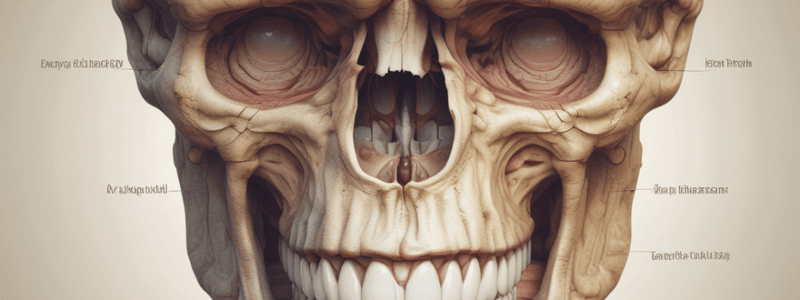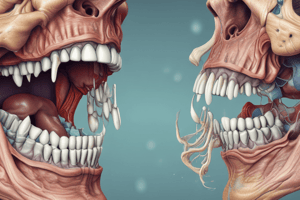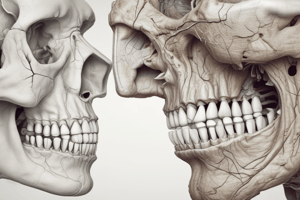Podcast
Questions and Answers
What is the primary function of the maxillary sinus?
What is the primary function of the maxillary sinus?
- To warm inspired air and decrease the weight of the skull (correct)
- To filter the air we breathe
- To aid in the production of mucus
- To humidify the air we breathe
What is the direction of the base of the maxillary sinus?
What is the direction of the base of the maxillary sinus?
- Anteriorly directed
- Medially directed (correct)
- Posteriorly directed
- Laterally directed
What is the name of the nerve that runs through the roof of the maxillary sinus?
What is the name of the nerve that runs through the roof of the maxillary sinus?
- Greater palatine nerve
- Anterior superior alveolar nerve
- Middle superior alveolar nerve
- Infra-orbital nerve (correct)
What is the location of the orifice of the maxillary sinus?
What is the location of the orifice of the maxillary sinus?
What is the shape of the maxillary sinus?
What is the shape of the maxillary sinus?
What is the distance of the floor of the maxillary sinus from the floor of the nasal cavity?
What is the distance of the floor of the maxillary sinus from the floor of the nasal cavity?
What is the name of the sinus that occupies the body of the maxilla?
What is the name of the sinus that occupies the body of the maxilla?
What is the purpose of the objectives of this lecture?
What is the purpose of the objectives of this lecture?
At what age does the maxillary sinus attain its full size?
At what age does the maxillary sinus attain its full size?
Which of the following teeth is NOT related to the maxillary sinus?
Which of the following teeth is NOT related to the maxillary sinus?
What is the primary location of the maxillary sinus?
What is the primary location of the maxillary sinus?
Which of the following is a radiographic examination method used to diagnose maxillary sinus affection?
Which of the following is a radiographic examination method used to diagnose maxillary sinus affection?
What is the term used to describe the cavity or hollow space of the maxillary sinus?
What is the term used to describe the cavity or hollow space of the maxillary sinus?
Which of the following is a type of maxillary sinus affection?
Which of the following is a type of maxillary sinus affection?
What is the term used to describe the spread of infection from a dental abscess of related teeth into the maxillary sinus?
What is the term used to describe the spread of infection from a dental abscess of related teeth into the maxillary sinus?
What is the term used to describe the recent investigation method used to diagnose pathological conditions of the maxillary sinus?
What is the term used to describe the recent investigation method used to diagnose pathological conditions of the maxillary sinus?
What is a common symptom of acute maxillary sinusitis that is exacerbated by bending the head downwards?
What is a common symptom of acute maxillary sinusitis that is exacerbated by bending the head downwards?
What is a characteristic feature of an oro-antral fistula in acute maxillary sinusitis?
What is a characteristic feature of an oro-antral fistula in acute maxillary sinusitis?
What is the primary goal of decongestants in the treatment of acute maxillary sinusitis?
What is the primary goal of decongestants in the treatment of acute maxillary sinusitis?
What is a characteristic feature of chronic maxillary sinusitis?
What is a characteristic feature of chronic maxillary sinusitis?
What is the primary goal of a Caldwell-Luc operation in chronic maxillary sinusitis?
What is the primary goal of a Caldwell-Luc operation in chronic maxillary sinusitis?
What is a common cause of traumatic affection of the maxillary sinus?
What is a common cause of traumatic affection of the maxillary sinus?
What is a characteristic feature of hematoma of the maxillary sinus?
What is a characteristic feature of hematoma of the maxillary sinus?
What is a possible complication of a hematoma of the maxillary sinus?
What is a possible complication of a hematoma of the maxillary sinus?
What is the purpose of injecting radio-opaque material, such as Lipidol, in the diagnosis of a fistulous tract?
What is the purpose of injecting radio-opaque material, such as Lipidol, in the diagnosis of a fistulous tract?
What is the recommended treatment for a small perforation of 1-2 mm?
What is the recommended treatment for a small perforation of 1-2 mm?
What is a characteristic of palatal flaps?
What is a characteristic of palatal flaps?
What is the purpose of using a palatal stent?
What is the purpose of using a palatal stent?
What is a characteristic of regional and distant flaps?
What is a characteristic of regional and distant flaps?
What is the term for the hard, calcified bodies with rough irregular surface found in the maxillary sinus?
What is the term for the hard, calcified bodies with rough irregular surface found in the maxillary sinus?
What is the advantage of using a Moczar flap?
What is the advantage of using a Moczar flap?
What is the recommended treatment for a large perforation of 5 mm or more?
What is the recommended treatment for a large perforation of 5 mm or more?
What is the primary goal of marsupilization treatment for cystic lesions?
What is the primary goal of marsupilization treatment for cystic lesions?
What is the term used to describe the complete removal of a cystic lesion?
What is the term used to describe the complete removal of a cystic lesion?
What is the primary characteristic of a benign tumor of the maxillary sinus?
What is the primary characteristic of a benign tumor of the maxillary sinus?
What is the treatment option for malignant granuloma?
What is the treatment option for malignant granuloma?
What is the primary goal of assessing clinical cases of oro-antral communication and fistula?
What is the primary goal of assessing clinical cases of oro-antral communication and fistula?
What is the term used to describe the retrieval of a foreign body, tooth, root, or instrument from the antrum?
What is the term used to describe the retrieval of a foreign body, tooth, root, or instrument from the antrum?
What is the primary characteristic of an oro-antral fistula?
What is the primary characteristic of an oro-antral fistula?
What is the primary goal of treatment for antral tumors?
What is the primary goal of treatment for antral tumors?
Flashcards are hidden until you start studying
Study Notes
The Maxillary Sinus
- Definition: Pyramidal-shaped air space occupying the body of the maxilla
- Anatomy:
- Roof: forms the floor of the orbit
- Apex: directed laterally
- Floor: lies 1 cm below the floor of the nasal cavity
- Base: formed by the lateral wall of the nasal cavity
- Orifice: lies in the upper part of the base, opens into the middle meatus of the nose
Nerves Related to the Maxillary Sinus
- Anterior superior alveolar nerve (in the anterior wall)
- Infra-orbital nerve (in the roof)
- Greater palatine nerve (behind the sinus)
- Posterior superior alveolar nerve (in the posterior walls)
- Middle superior alveolar nerve (in the lateral wall)
Function of the Maxillary Sinus
- Warms inspired air and decreases the weight of the skull
- Improves sound resonance
Teeth Related to the Maxillary Sinus
- First molar, second molar, second premolar, third molar, and first premolar (in that order)
Diagnosis of Maxillary Sinus Affection
- History: e.g., diffuse toothache with a history of common cold
- Clinical examination: percussion, palpation, and trans-illumination
- Radiographic examination:
- Intra-oral periapical and occlusal film
- Panoramic x-ray
- Water's view: occipito-mental produce for simultaneous comparison of both sinuses
- Sinoscopy: a recent investigation method for diagnosing pathological conditions of the maxillary sinus
Maxillary Sinus Affections
- Inflammatory (e.g., sinusitis)
- Traumatic (e.g., fractures, hematomas)
- Calcifications (e.g., antral rhinoliths)
- Cysts (e.g., odontogenic, non-odontogenic)
- Tumors (e.g., benign, malignant)
Oro-Antral Communications and Fistulae
- Definition: Oro-antral communication is a passage between the oral cavity and the maxillary sinus, while an oro-antral fistula is a small opening between the two
- Aetiology: dental origin, nasal origin, facial fracture, etc.
- Assessment: radiographic examination, sinoscopy, etc.
- Management: antibiotics, decongestants, analgesics, closure of oro-antral fistula, etc.
Acute Maxillary Sinusitis
- Clinical features:
- Pain referable to the specific sinus area
- Interference with smell
- Dental pain or pain of teeth related to the sinus
- Foul unilateral nasal discharge or nasal obstruction
- Presence of oro-antral fistula
- Treatment: antibiotics, decongestants, analgesics, removal of the cause, etc.
Chronic Maxillary Sinusitis
- Clinical features:
- No pain
- Smell is often impaired
- Foul odor
- Presence of oro-antral fistula or polypoidal reddish mass
- Trans-illumination reveals opacity of the affected side
- Treatment: removal of the dental cause, Caldwell-Luc operation, etc.
Traumatic Affections
- Hematoma of the maxillary sinus
- Fracture of the middle third of the face
- Fracture of the tuberosity of the floor of the sinus during extraction
- May occur from nasal operations
- Treatment: X-ray films, injection of radio-opaque material, gutta percha test, etc.
Closure of Oro-Antral Fistula
- Small perforation (1-2 mm): blood clot will fill it and close automatically unless infected
- Medium-sized perforation (2-5 mm): close it immediately by approximation of buccal and palatal tissues with tight sutures
- Large perforation (5 mm or more): surgical closure is needed
- Types of flaps:
- Local flaps (buccal, palatal)
- Regional flaps (tongue flaps)
- Distant flaps (temporalis flaps)
Calcifications
- Antral rhinoliths
- Hard, calcified bodies with a rough, irregular surface
- Radiographic picture: rounded, lightly opaque shadow partially obliterating the sinus
- Treatment: enucleation, marsupialization, or marsupialization followed by enucleation
Cysts
- Odontogenic cysts (e.g., ameloblastoma, adenoma)
- Non-odontogenic cysts (e.g., osteoma, fibro-osteoma)
- Treatment: surgical excision, marsupialization, or marsupialization followed by enucleation
Tumors
- Benign tumors (e.g., osteoma, fibro-osteoma, adenoma)
- Malignant tumors (e.g., epidermoid carcinoma, adenocarcinoma, malignant lymphoma)
- Treatment: surgical excision, irradiation, cytotoxic drugs, and corticosteroid therapy
Studying That Suits You
Use AI to generate personalized quizzes and flashcards to suit your learning preferences.




